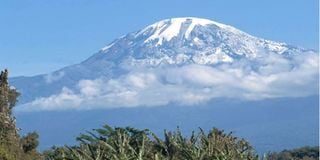Breaking: Autopsy reveals how Cyrus Jirongo died
Five things to know about Tanzania

A view of Mount Kilimanjaro.
Dar es Salaam
Known for its wildlife-rich national parks and the highest mountain in Africa, Tanzania is a tourism draw but has seen its share of political turmoil in recent years.
On Wednesday, President John Magufuli died at age 61, after a prolonged absence from public life in the East African nation.
Here are five things to know about Tanzania:
Kilimanjaro to the Serengeti
At 945,000 square kilometres, Tanzania is the biggest nation in East Africa, bordered by eight countries and the Indian Ocean.
Tanzania boasts Africa's highest peak, Mount Kilimanjaro, and the world's second largest and deepest lake, Lake Tanganyika.
The wildlife-rich Serengeti National Park and Ngorongoro volcanic crater lure hundreds of thousands of tourists annually.
Another major draw for visitors is the sandy beach archipelago of Zanzibar, famed for its turquoise waters and spice farms.
The official capital of Tanzania is Dodoma, although the economic heart is the port city of Dar es Salaam.
Diverse, but united
Tanzania has around 120 ethnic groups, but does not have a single dominant group -- unlike most of its neighbours. Ethnicity is not a major driver of political affiliation or political violence.
The country has an estimated population of 58 million, and Swahili and English are the official languages.
About 60 percent of the population is Christian, and 35 percent are Muslim. On the semi-autonomous archipelago of Zanzibar however, 99 percent are Muslim.
German, then British occupation
The British established a protectorate on Zanzibar in 1890, while Germany took control of the mainland in 1891.
German East Africa became British territory in 1920 and took the name Tanganyika. It became independent in 1961 and the country's founding father Julius Nyerere was elected president one year later.
Mainland Tanganyika merged with the Indian Ocean islands of Zanzibar and Pemba to form Tanzania in 1964, but the islands have kept a semi-autonomous status with a separate president.
Tanzania held its first multi-party elections in 1995 and the ruling Chama Cha Mapinduzi (CCM) party has won every election since.
President John Magufuli, who succeeded Jakaya Kikwete and Benjamin Mkapa, was elected in 2015 and won a disputed poll last year.
The vice president announced his death from a "heart condition" on Wednesday.
Magufuli was last seen in public on February 27 and his absence sparked rumours that he had Covid-19, which he had insisted no longer existed in Tanzania.
Troubled polls
Sectarian and political tensions in Zanzibar -- with a cosmopolitan population of Arabs, Asians and Africans -- are more marked than on the mainland.
The archipelago has a history of controversial and violent elections, with the opposition charging the ruling party has stolen every election since 1995. Foreign observers have often agreed.
In January 2001 at least 30 people were killed in clashes between police and opposition supporters after a disputed election.
A political deal allowing for more power-sharing led to peaceful elections in 2010, but divisions quickly returned and in 2015, the head of the electoral commission cancelled the entire vote.
The opposition boycotted the re-run in 2016 and the CCM was declared the victor.
An election in October last year also led to widespread violence on the island.
Magufuli was declared the winner of the overall presidential election with 84 percent of the vote, but many dismissed the process as a sham.
Security forces cracked down against any protests following the vote, and around 150 opposition members were arrested.
Gold, cloves and coffee
Agriculture is the biggest sector, employing the vast majority of the workforce, and contributing around 30 percent to gross domestic product.
Gold is the main export and foreign exchange earner. The country also exports cashew nuts, cotton, cloves and sisal, coffee, tea and tobacco.
After over six percent annual growth for the past decade, gross national income in 2019 surpassed the World Bank threshold of $1,036 for lower-middle income status.
However, due to high population growth, the number of poor citizens has actually increased from 13 million in 2007 to 14 million, according to the bank.





